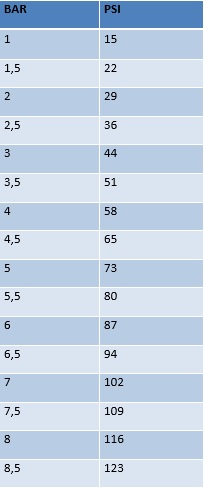
How is tyre pressure measured ?
The physical volume used to measure the amount of air in a tyre is pressure. This indicates the force per unit exerted on a surface by the compressed air. In general, cyclists use one of two methods to measure pressure:- BAR - measurement in the metric system (mainly used in continental Europe, Asia …), which corresponds to around a 1kg force per square centimetre. That is why we often say a “kilo” in the peloton to indicate a bar. - PSI – pounds per square inch which is more commonly used in Anglo-Saxon countries and is almost exclusively used to measure shock absorber pressures.
What are the advantages and disadvantages of using a CO2 cartridge for inflation?
Zéfal’s CO2 inflators are fast, long-lasting, easy-to-use and very reliable. They are most commonly used in competitions and long-distance mountain rides. They are easily carried and simple to use allowing you to repair your bike quickly and efficiently. If you want to save time when out, then using CO2 inflators is the perfect way to do this. Using a CO2 inflate with a cartridge allows you to almost instantly inflate your tyre. It has been designed for flat tyres during competitions (century ride, triathlon). This type of inflation is less convenient in terms of the environment and cost. Once used, the cartridge is empty and needs throwing away. Be sure that your tyre is correctly in place before inflating it with CO2. Some pumps can be used with a CO2 cartridge which gives it a double function.
What pressure should i inflate my tyre to ?
The recommended tyre pressures are on the sidewall of the tyre. The right pressure depends on the weight the tyre will hold, the type of bike and its usage as well as the terrain. Make sure that you keep to the maximum pressure that your tyre can take. It is indicated on the side of your tyre. The graphs below show pressure in relation to weight (of the cyclist and any bags, excluding the weight of the bike):
Recommended pressure for a road tyre against weight of the cyclist: 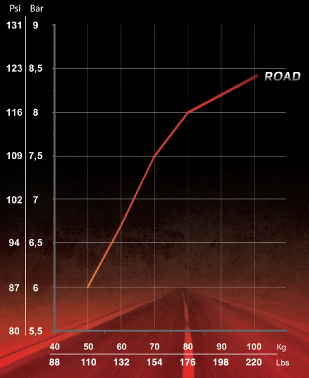 Recommended pressure for a mountain bike against weight of the cyclist and type of activity:
Recommended pressure for a mountain bike against weight of the cyclist and type of activity:  For urban bikes or kids’ bikes, the pressure will depend on the size of the tyre (diameter and width). There is a large variety available depending on the model. It is important to use whatever is written on the side of the tyre.
For urban bikes or kids’ bikes, the pressure will depend on the size of the tyre (diameter and width). There is a large variety available depending on the model. It is important to use whatever is written on the side of the tyre.
What are the differents types of valves used on bike tyres ?
A bike valve is what allows the inner tube to be inflated and deflated. In principle, there are three possible types of bike valve on an inner tube: The Schrader or American valve (also used on motor vehicles) is the most robust. Its simple mechanism uses a spring locking system and is the reason that it is the most universally used valve for entry-level and mid-range bikes. This valve is compatible with service station pumps. It can also be used with a bicycle pump. 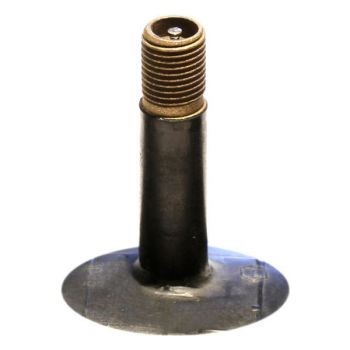
Schrader valve
The Presta or French valve is slimmer than other valves. It has a reduced diameter of 6mm compared with the Schrader’s 8mm meaning it is more compatible with thin rim tape and therefore less fragile. That is why the Presta valve is more commonly heard of with road bikes. It can be manually closed using a little spanner which is needed to inflate the inner tube. Zéfal actually invented the Presta valve at the beginning of the 20th century. 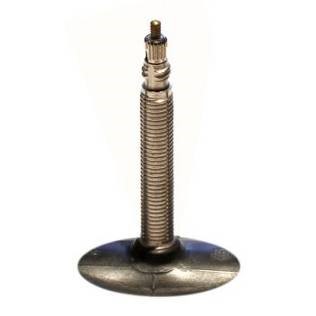
Presta valve
The Dunlop or English valve mechanism is easy to replace and allows a rapid evacuation of air. Assembling an inner tube with a Dunlop valve takes a bit longer because the valve mechanism and the tightening bolt need removing through a piercing in the tape. This model is only possible on certain bikes like the Dutch urban bikes and only really heard of in certain countries (like Scandinavia or Japan). 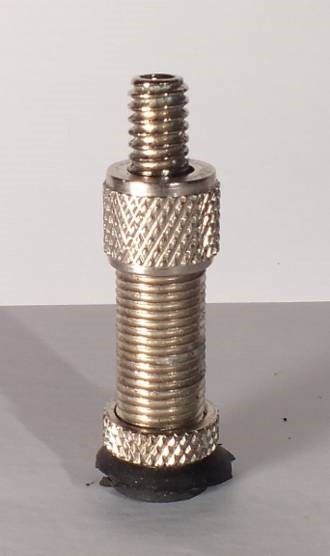
Dunlop Valve
Which types of bikes will find this valves on?
The Schrader valves are used on motor vehicle tyres and are also found more commonly on mountain bikes, urban bikes and entry-level bikes; the Presta valves are mainly found on road bikes, urban bikes or on top-end special mountain tyres; Dunlop valves are found on bikes like Dutch bikes (if this is you, then it is important to check that your pump is compatible).
I have a dunlop valve, how do i use my mini ZÉFAL pump with this connector?
Our pumps that have the Z-Flip and Z-Switch connectors are compatible with the Dunlop valve. You will need to use an adaptor for our other pumps, which is available from our individual parts section. (Inflator Kit). This adaptor means you can use our whole range of pumps with a Dunlop connector. You will just need to attach the adaptor to the valve and then use the Presta valve connection on your pump.
Do i need to check my tyre pressures before every ride ?
The right level of inflation is important when cycling to reduce the risk of:
-Flat tyres,
-Tyre becoming unseated from the rim,
-Poor performance due to lack of grip,
-Falling.
A higher pressure means the rolling resistance, wear and tear and the risk of punctures is limited. If the pressure is weaker, the suspension becomes more comfortable and the tyre grip is better. You therefore need to have a pressure that brings the best balance between comfort, output and avoiding punctures. For sports use, it is advisable to monitor and check your tyre pressure before each ride. For urban or leisure use, it is advised that you check your tyre pressures at least once a month. The inner tubes are slightly porous and will allow air to escape over time. Pressure can be controlled with the help of the TWIN GRAPH or a pump equipped with a pressure gauge. Please note that the pressure in tubeless tyres must be checked before each ride. Using a foot pump to inflate your tyres allows you to increase pressure quicker. Similarly, using a manometer or pressure gauge during inflating will increase the accuracy.
Can you explain the different technologies detailed on the packaging of your pumps and on your website?
ZEFAL INFLATION SYSTEMS
Z TURN : A screw-on connector that is compact and intuitive. The Z-turn can be adapted to Presta and Schrader valves. The grooves at the end allows for a better grip and an easier connection. Available for Air Profil FC01, FC02, FC03, EZ Max FC pumps.
Z FLIP : The Z-Flip system is a reversible simple-to-use connector. Its all-in-one-system lets you quickly change from one valve to another. Compatible with Presta, Schrader and Dunlop valves. Available for Z Cross XL, Z Cross AL.
Z SWITCH : A smart connector that quickly and instantly adapts to all valves using a simple switch. Compatible with Presta, Schrader and Dunlop valves. Available for Air Profil Switch, Profil Max FP20, FP30, FP60.
Z TWIN : A double-head screw connector allowing a quick and easy change between valves. The Z-Twin system is most suited to high pressures. The shape of the end piece guarantees that the connection to the valve is sealed. Compatible with the Presta and Schrader valves. Available for Profil Travel.
Z FLOW : The Z-Flow system ensures a controlled flow of gas from the CO2 cartridge. By simply rotating, the system controls the gradual release of gas and ensures an accurate inflation as per your requirement. Compatible with the Presta and Schrader valves. Available for EZ Control FC and EZ Control inflators.
Z PUSH : The Z-push system ensures a controlled quantity of CO2 gas injected by a simple push.The Z-Push guarantees a perfect seal for the best inflation. Compatible with the Presta and Schrader valves. Available for EZ Big shot inflators.
Z LINE : The Z-Line systems ensures a smooth, linear inflation. It requires less effort at high pressure. Available for the Z Cross XLhttps://www.zefal.com/en/mini-pumps/58-z-cross-xl.html pump.
Z HPX : 2 in 1 system allowing high pressure inflation while ensuring mounting on all conventional frames without fasteners.
How to choose a mini-pump ?
The body of the pump where the air is compressed is cylindrical in shape. The diameter of the cylinder needs to correlate to the cross-section of your tyres – the bigger the pumps diameter, the greater the volume of air delivered in (less pumps needed) but it will achieve less pressure. You will need a pump with a small diameter to achieve high pressures for thin tyres and a wider pump for wider tyres which inflate at low pressures. Therefore a road bike tyre has a low volume but needs to be inflated to high pressures. A mini-pump adapted for the road will have a small body diameter. We recommend the AIR PROFIL MICRO or the AIR PROFIL FC02 from our range, for example. On the flip side, a mountain bike tyre requires a larger volume but lower pressure to be inflated. The most suitable mini-pump would be larger in diameter. Our range of mini-pumps Z Cross AL, Z Cross XL and AIR PROFIL FC01 have been designed for inflating mountain bike tyres. There are also pumps for more universal use like the AIR PROFIL XL which can be used for road, mountain or urban and leisure bikes.
Is a mini foot pump as effective as traditional foot pump ?
Mini foot pumps will be able to reach practically the same pressure. You will just need to pump a few more times (the body of the pump being smaller).
When i'm inflating my tire, my mini pump heats up is there a problem ?
Contrary to what you might think, the heat that builds up is not due to friction coming from poor product quality, but from an unavoidable physical change. Compression of air naturally causes a heat-generating reaction. It also results from the Second Law of Thermodynamics. This law explains that when you deflate your tyres, the expelled air is cold or why when you inflate your tyres with a compressed gas cartridge, it is best to protect your fingers from the cold from the cartridge.
Why should i choose an aluminium pump ?
The pump will heat up when inflating and will reach high pressures. Aluminium has a better resistance to strong heat compared to plastic. Aluminium pumps are longer-lasting and are less likely to be damaged.
What is the advantage of a telescopic tube ?
A telescopic tube means the tyre can be inflated quicker. The two tubes mean air is being inserted at two points and also that 30% more air is being pumped in each time compared with a classic pump without taking up any more space.
Are individual pieces available for my pump (connector, seal ...) ?
We are proud of the resilience of our products and also our after-sales customer service. Individual pump parts are available for sale for current and older models on the following page "Spare parts".Some parts of the pump are more susceptible to wear and tear; in particular the piston. The connector can be changed on foot pumps and flexible connector pumps, whilst the gaskets on the head of direct connection pumps will deteriorate over time. If you can’t find the piece you need or you have any other questions, please do not hesitate to contact us using the form.
How do I remove the pressure gauge dial on the Profil Max FP60, FP30 and FP20 pumps?
For technical support on our products, please contact sav@zefal.com.
How do I maintain my Zéfal pump?
Our pumps have been designed to last with the minimum of maintenance. However, to maximize the life of your pump, we recommend that you lubricate the mechanism by inserting a drop of oil a few times a year. Any mineral oil is suitable. We particularly recommend our PRO WET LUBE oil. Otherwise, all spare parts are available from our service department "Spare parts"
How can PSI measurements be converted into bar?
There are two measures of pressure that are used for tyre pressure – PSI and BAR. 1 bar is equal to 14.51 psi. The recommended pressures are on the sidewall of your tyre and they are normally shown in 2 measures. However, the fork and shock absorber pressures are often only shown in PSI.
Which pump do you recommend for use with forks and shock absorbers?
You need to make sure that you get a pump that is designed for suspensions. They allow you to reach high, precise pressures. The Zéfal model : Z SHOCK.
I have a pump with a spring handle, how do I attach it to my bike?
There are two types of pumps with spring handles – traditional pumps and frame-fit pumps. Traditional pumps are more common. They are mounted between existing holes (on the frame or bag rack) or by adding two plastic clips onto the frame which hold the pump. These clips are available for sale as individual items. Frame-fit pumps are mounted between two tubes on the frame. There are different lengths to ensure the best fit to your bike.
Can several types of cartridges be mounted on the CO2 Holder?
All cartridges can be mounted on a CO2 Holder, with the exception of two 25g cartridges (which are too large in diameter). Here is the list of possible mountings:
12 g + 12 g
16 g + 16 g
12 g + 16 g
12 g + 25 g
16 g + 25 g
What is the point of CO2 apart from speed?
This is the main interest. It can also be very useful to replace a tubeless in the field or at home if the person does not have a tubeless tank.
What are the existing, different types of cartridges?
There are 2 types of CO2 cartridges – threaded and non-threaded. Your cartridge and firing pin need to be compatible. After that, the differences depend on the quantity of air in the cartridge and of your discipline. Zéfal sells tow air capacities 16 g and 25 g, threaded. The choice depends on your discipline and the size of your tyres. Pressures table by type of cartridge
Can I recycle CO2 cartridges?
Zéfal’s CO2 cartridges are made from steel and are 100% recyclable. Empty CO2 cartridges can be put in any recycling that accepts steel.
Do balls need a specific type of pump?
You need to use a specific adaptor for balls that is either needle or cone-shaped. Some pumps are supplied with a needle or cone connection (LIEN) like the MAX or most of our foot pumps. We also supply conversion kits which allow you to inflate balls, air beds … using any bike pump.


